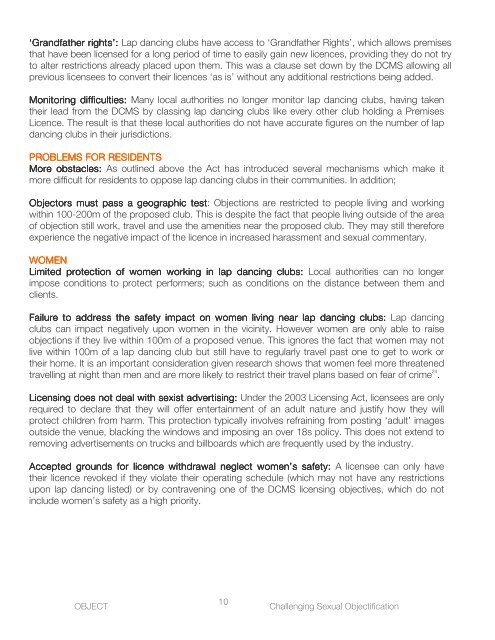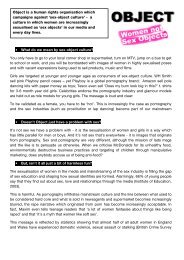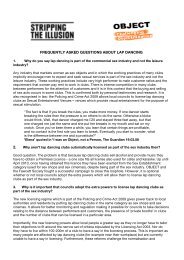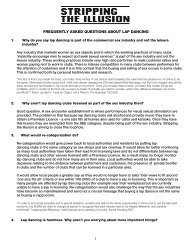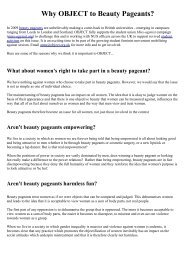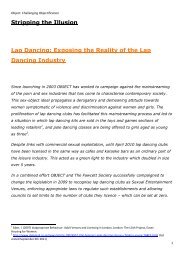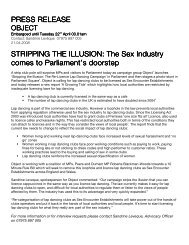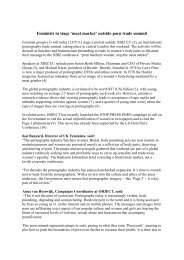a growing tide: local authorities restricted by inadequate ... - Object
a growing tide: local authorities restricted by inadequate ... - Object
a growing tide: local authorities restricted by inadequate ... - Object
Create successful ePaper yourself
Turn your PDF publications into a flip-book with our unique Google optimized e-Paper software.
‘Grandfather rights’: Lap dancing clubs have access to ‘Grandfather Rights’, which allows premises<br />
that have been licensed for a long period of time to easily gain new licences, providing they do not try<br />
to alter restrictions already placed upon them. This was a clause set down <strong>by</strong> the DCMS allowing all<br />
previous licensees to convert their licences ‘as is’ without any additional restrictions being added.<br />
Monitoring difficulties: Many <strong>local</strong> <strong>authorities</strong> no longer monitor lap dancing clubs, having taken<br />
their lead from the DCMS <strong>by</strong> classing lap dancing clubs like every other club holding a Premises<br />
Licence. The result is that these <strong>local</strong> <strong>authorities</strong> do not have accurate figures on the number of lap<br />
dancing clubs in their jurisdictions.<br />
PROBLEMS FOR RESIDENTS<br />
More obstacles: As outlined above the Act has introduced several mechanisms which make it<br />
more difficult for residents to oppose lap dancing clubs in their communities. In addition;<br />
<strong>Object</strong>ors must pass a geographic test: <strong>Object</strong>ions are <strong>restricted</strong> to people living and working<br />
within 100-200m of the proposed club. This is despite the fact that people living outside of the area<br />
of objection still work, travel and use the amenities near the proposed club. They may still therefore<br />
experience the negative impact of the licence in increased harassment and sexual commentary.<br />
WOMEN<br />
Limited protection of women working in lap dancing clubs: Local <strong>authorities</strong> can no longer<br />
impose conditions to protect performers; such as conditions on the distance between them and<br />
clients.<br />
Failure to address the safety impact on women living near lap dancing<br />
clubs: Lap dancing<br />
clubs can impact negatively upon women in the vicinity. However women are only able to raise<br />
objections if they live within 100m of a proposed venue. This ignores the fact that women may not<br />
live within 100m of a lap dancing club but still have to regularly travel past one to get to work or<br />
their home. It is an important consideration given research shows that women feel more threatened<br />
travelling at night than men and are more likely to restrict their travel plans based on fear of crime 24 .<br />
Licensing does not deal with sexist advertising: Under the 2003 Licensing Act, licensees are only<br />
required to declare that they will offer entertainment of an adult nature and justify how they will<br />
protect children from harm. This protection typically involves refraining from posting ‘adult’ images<br />
outside the venue, blacking the windows and imposing an over 18s policy. This does not extend to<br />
removing advertisements on trucks and billboards which are frequently used <strong>by</strong> the industry.<br />
Accepted grounds for licence withdrawal neglect women’s safety: A licensee can only have<br />
their licence revoked if they violate their operating schedule (which may not have any restrictions<br />
upon lap dancing listed) or <strong>by</strong> contravening one of the DCMS licensing objectives, which do not<br />
include women’s safety as a high priority.<br />
OBJECT<br />
10<br />
Challenging Sexual <strong>Object</strong>ification


